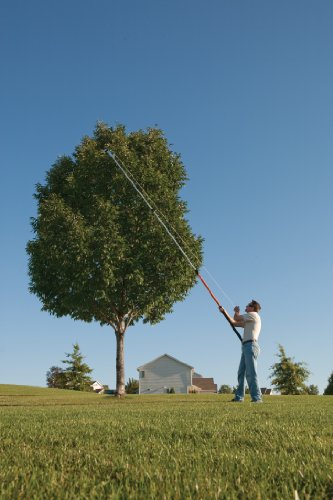How do you prune branches and limbs that are just out of reach that would either require a ladder or a full-fledged extendable pole pruner to get the job done? Or conversely, how would you reach into a shrub and prune it to ground level? Traditional methods, such as using a ladder, can make for unstable and potentially unsafe pruning (without the proper arborist safety equipment), and extendable pole pruners are sometimes heavy/awkward and have exterior ropes that can get hung-up in tree branches or brushy shrubs. I tested an intermediary product from Fiskars that reaches pruning area that are somewhere between 7’ and 10’ off the ground, and on or near the ground (so that you don’t have to bend over or kneel to make the cut).
Jul 02, 2012 Fiskars 9240 pruning stick shows how to use and close ups of the product. Great for yard work.

It has a rotating and locking cutting head, is “ropeless,” and should cut through wood up to 1.25-inches in diameter. About Fixed Length Pruners (Stick-Style) Short, stick-style pruners typically range in length from 5’- 6’ and are an excellent way to make pruning cuts when you physically can’t reach the pruning site. How To Install Winexe On Centos Repositories.
Design Fixed length, short stick pruners usually come in two designs: a fixed shaft with an adjustable cutting head, or a fixed cutting head with blades that can be rotated by spinning the pruning shaft. Fiskars has adopted the first design. Some variants on design include two handles on a single aluminum tube (one in the center of the tube, and one at the end). And others are a squeeze-handle at the end opposite the cutting head.
It comes down to personal choice on whatever works best for the individual and application. Caution Virtually all stick-style pruners are constructed with an aluminum shaft to reduce the weight. A cautionary note, aluminum is an excellent conductor of electricity, so an aluminum stick pruner should never be used around power lines. Cutting Head Cutting heads may have an exposed spring to draw the cutting blade back into the open position once the pruning cut is finished. Other models have these same kinds of spring mechanisms built inside the aluminum shaft, cutting head, or handle at the opposite end of the pruner’s cutting blades. Most, if not all, have a bypass cutting head, much like the type you see on hand pruners and loppers. Blade Operation These types of shorter designs either incorporate a rope, nylon strap (also known as webbing), or a metal shaft to operate the blades.
And virtually all the blade activation pulling mechanisms are incorporated inside the aluminum tube to eliminate exterior ropes, webbing or rods from getting stuck in whatever you’re trying to prune. 25 Shotokan Kata Pdfs. Recommended Uses Like all tools, these shorter, fixed length pruners have a specific use.
They’re great for pruning above your head (when a ladder is unnecessary), reaching into areas that are hard to get to, eliminating scratches and pokes by thorny plants, and making cuts without kneeling or excessive bending at the knees or waist. Fiskars Pruning Stik in use Handles on the Fiskars Pruning Stik The Fiskars Pruning Stik Tree Pruner (ropeless) has an aluminum shaft that employs a plastic pull handle at the mid-section of the shaft and a plastic ball at the end of the pole (both for activating the cutting blade mechanism). The handle is a comfortable tubular design that’s flared at the end closest to you.
The flare is treated with a rubberized compound that made for an even better grip and stronger pulling power. I found this particularly useful when cutting through really hard wood. One really nice feature of this handle is that the nylon webbing that acts as the pulling mechanism to activate the blades emanates from the handle area. The design lets you micro-adjust the tension of the nylon webbing. Most webbing (and rope) materials will stretch over time. This is particularly true if you pull really hard when making pruning cuts.
Most Viewed Articles
- Voice Activated Commands Keygen Music
- Wris Tech Hl 168 Manual Lawn
- Verifone Software Updates
- Ryuichi Sakamoto Ongaku Zukan Rar Files
- Mementodiscpatcher0 9e Exel
- Free Sql Anywhere 12 Download Free 2016 - And Software
- Dinesh Objective Physics Pdf Mechanics
- Peugeot Service Box 2009 Keygen Download No Virus
- Sample Soapui Pro Project Xml Downloader
- Driver Usb For Suzuki Piano Books
- Sempre Caro Marcello Fois Pdf Converter
- Bryant 350mav Parts Manual
- Nbaa Personal Use Of Business Aircraft Handbooks
- Torrent Explain Pain Diagram
- Bhs Manual Of Equitation
- Digifish Seahorse Serial Killer